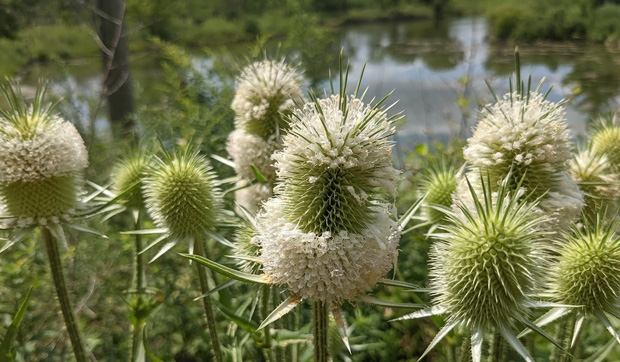Two species of teasel occur in Illinois, Dipsacus fullonum and D. laciniatus, and both are equally invasive. The plants were bought to the United States intentionally but escaped cultivation and have proliferated, especially in disturbed areas. Photo by Greg Swedberg
Good Natured: Teasel
July 21, 2023
Greetings Good Natured readers! This week’s column comes to us courtesy of Greg Swedberg, a St. Charles resident and astute observer of our natural world. Here he shares his thoughts on teasel, a plant that’s been introduced, at first on purpose and then by accident, throughout our region:
Kelly and I went for a bike ride along the Cal-Sag Canal in the Forest Preserve District of Cook County on Saturday, and for something with a name as unpleasant-sounding as “The Cal-Sag Canal”, it was surprisingly, even remarkably beautiful. The bike path was well-paved and maintained, and meandered through woods and savannah areas, and big open restored prairies. It actually reminded us a lot of the Fox River Trail, but not as heavily trafficked. It was absolutely worth the drive.
Anyway, back to those “restored prairies”. Unfortunately, many of them were just chock-a-block packed full of this weird, extremely tall, multi-headed, spiky-looking plant.
There were some areas where there would be a mile or so of prairie on either side of the path, and suddenly the bluestem and the black-eyed Susans and coneflowers and Queen Anne’s lace would give way to entire fields of just this enormous, dangerous looking plant.
The flower, stems, and even the leaves are covered in sharp, pointy shards. Where it was established, it made the area appear entirely impassable. It was as if barbed wire had come to life and had become a plant. Honestly, considering how sharp it looked and how much of it there was, it was kind of scary.
I Googled this photo and it came back as “teasel,” (Dipsacus spp.) native to Asia and Europe. It was introduced here for an economic purpose, providing a handy Industrial Age-era “tease” to help fluff wool into felt. Its flowers were also dried and added to bouquets. Those manufacturing and aesthetic reasons are long gone now, having been replaced by machines and by, I guess, less aggressive-looking flowers. But the teasel remains, and has grown to be quite a nuisance, so much so that the Department of Agriculture in Minnesota — where it has apparently not gained a foothold yet — has a “kill on sight” order against the plant.
I’m honestly not surprised for the State of Minnesota’s dramatic response. When we got back from our ride, driving around yesterday, now that I knew what to look for, I saw it everywhere. Next to roadsides, against fence rows, in ditches, near wetlands of varying quality, near subdivisions, and even near our house along the abandoned railroad right-of-way right through St. Charles, the imposing stands can be hundreds of feet long!
It seems like once it’s established it’s pretty adept at staying put and spreading out, creating a monoculture and crowding out native species. The flower head creates hundreds of tiny seeds which are caught easily by the wind. Mowing is particularly ineffective at controlling the plant, which tends to spread the prolific seeds more widely, as is prescribed burning, which opens up even more area for the teasel to colonize.
The Illinois Department of Natural Resources recommends applying glyphosate — which we all know as Roundup — to areas where it has set up shop. I think we can all agree that Rounding-Up a native prairie to control teasel, especially considering how widespread it appears to be, seems cost-prohibitive and wildly environmentally unsustainable. But it doesn’t seem like there are many better options. I would hate to see our own forest preserves and parks be taken over by teasel, but considering how widespread it appears to be, it seems like it’s practically inevitable.
I know we should want to avoid pejorative adjectives like “bad”, “invasive”, or “destructive” when describing introduced species which are just doing what nature has selected them to do, but our bike ride along the Cal-Sag gave us a bit of a look directly into the maw of what happens when one particular introduced species thrives in its new environment. If teasel isn’t bad, invasive, or destructive per se, it is at least very, very spiky!
As Greg mentioned, herbicide is one means of bringing teasel under control, and is the most efficient option for large-scale infestations. But the chemicals carry significant risks, and they’re not effective on flowering plants. Mowing doesn’t work either as the plants’ roots fuel regrowth.
So what can we, the ordinary, Dipsacus-detesting masses, do to stem the teasel tide? For that insight we turn to another Good Natured friend, Mary Alice Masonick. She served as the volunteer steward at Burnidge Forest Preserve in Elgin for 10 years and during that time saw teasel rise and fall. Here’s what she does to preserve those results:
I go out in late July or early August to look for teasel in Burnidge (and other places in the area). There once were five or so sites to visit. Now, there are two sites that may have one or two plants. I never herbicided the basal leaves but the forest preserve crew did. It’s almost been eradicated (knock on wood).
I cut off the whole stalk at the ground with loppers and then cut off the seed heads and bag them (for disposal). I do it late enough in the summer that I hope the stems won’t grow back, although sometimes teasel rebounds and there is a shorter plant that reflowers (and must be recut).
Big thanks to Greg and Mary Alice for sharing their thoughts! Now that our eyes are open to the terror that is teasel, we can work together to tame this invasive beast.
Pam Otto is the outreach ambassador for the St. Charles Park District. She can be reached at potto@stcparks.org.

